

 The Accurate Reloading Forums
The Accurate Reloading Forums  THE ACCURATE RELOADING.COM FORUMS
THE ACCURATE RELOADING.COM FORUMS  Guns, Politics, Gunsmithing & Reloading
Guns, Politics, Gunsmithing & Reloading  Reloading
Reloading  Anybody else shoot "unclean" brass and live to tell about it?
Anybody else shoot "unclean" brass and live to tell about it?Go  | New  | Find  | Notify  | Tools  | Reply  |  |
One of Us |
IOW OMG FWIW nuts! ____________________________________ There are those who would misteach us that to stick in a rut is consistency - and a virtue, and that to climb out of the rut is inconsistency - and a vice. - Mark Twain | Chinese Proverb: When someone shares something of value with you and you benefit from it, you have a moral obligation to share it with others. ___________________________________ | |||
|
| One of Us |
I'm familar with obsessive-compulsive disorder. But not familar enough to abbreviate it. Nor, for that matter, have I seen it applied to reloaders. Anal perhaps yes; OCD no. Aim for the exit hole | |||
|
| One of Us |
Hey woods, Please tell us your proceedure in beautifying your cases like that! | |||
|
one of us |
I like my brass clean. I do not like running dirty fired cases into my sizing dies. I like all metal parts clean. I like my dies to stay clean, my shells to stay clean and my rifle chambers to stay clean. That is just the way I roll. It is personal preference. My fired brass goes into a vibrator tumbler, then rinsed, then sized, then tumbled again, then rinsed. I would actually prefer to use Woods's method and I remember him posting pics awhile back but don't remember where. I doubt there's a lick of difference in a hunting rifle using multiple fired hulls v. clean and shiny. But, I'll keep mine clean and shiny. Ted Kennedy's car has killed more people than my guns | |||
|
One of Us |
Okay I use a Lee Zip Trim mounted on a piece of 2x4 in a vise on the bench 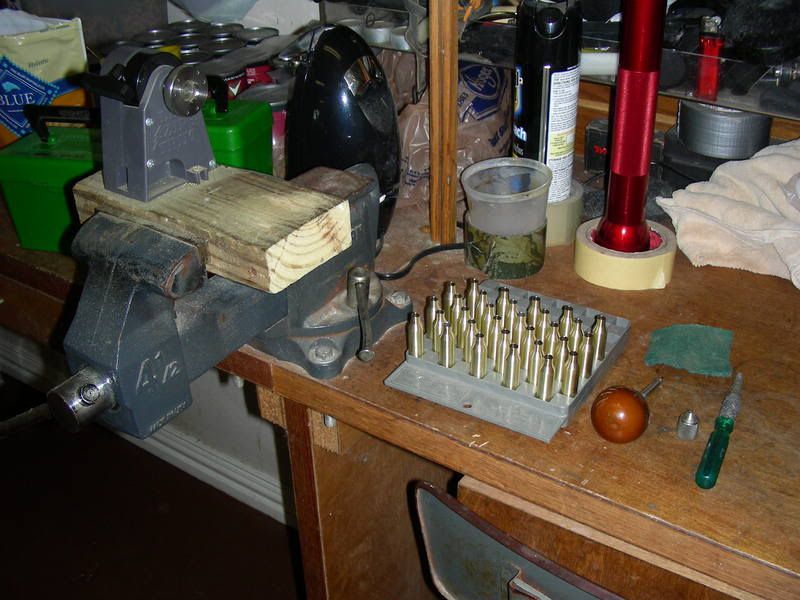 Each case gets trimmed, chamferred first 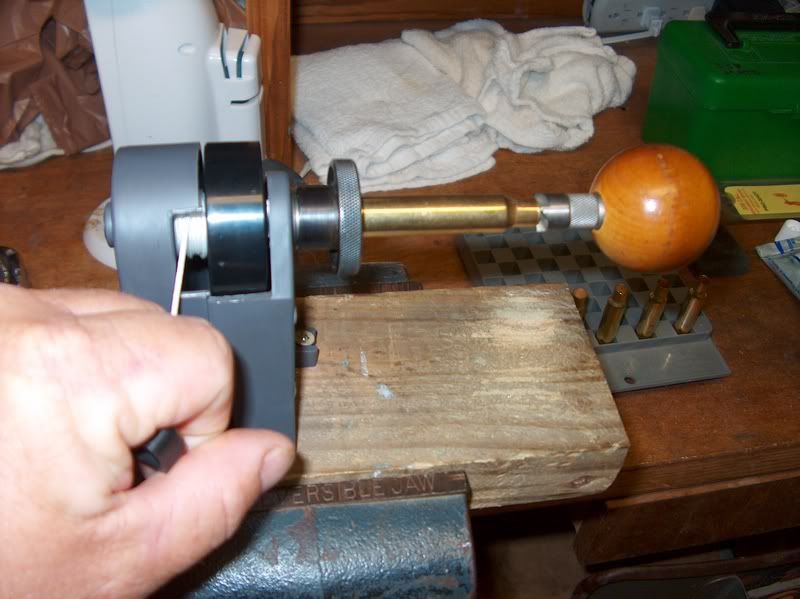 then I spread a line of Flitz 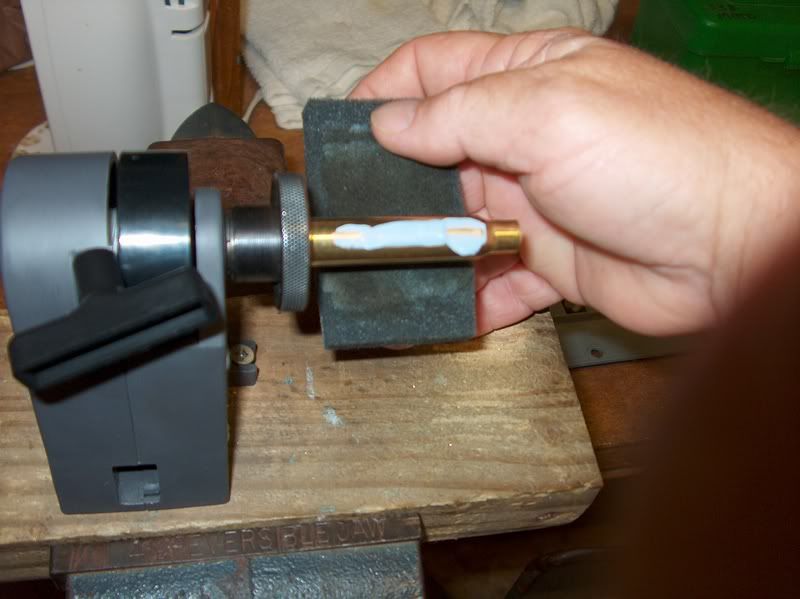 use one of those sponges that come in the top of a box of Barnes bullets to clean  hold a rag against it and spin a couple of times 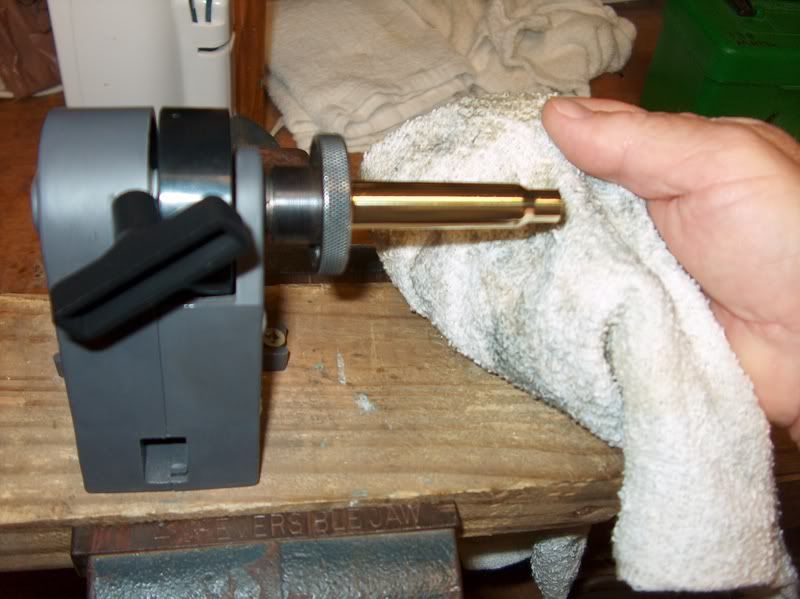 then you're ready to clean the inside of the necks  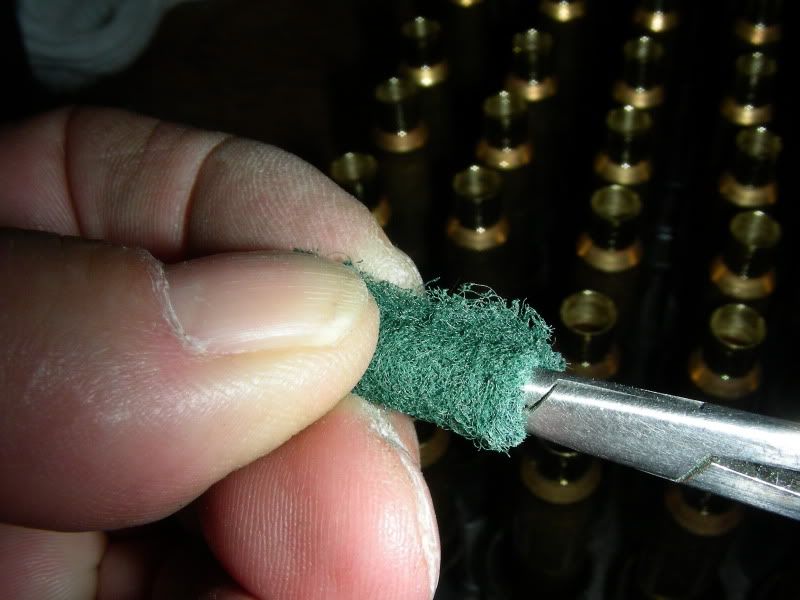 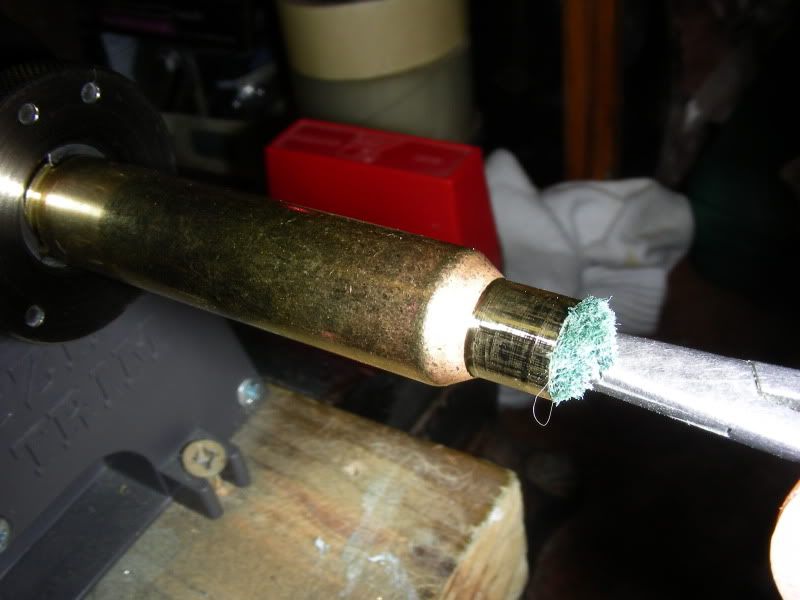 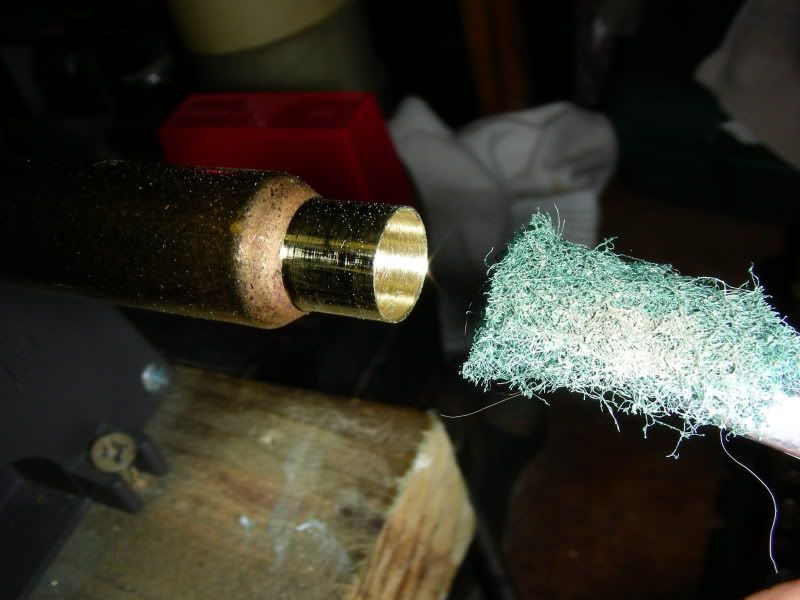 50 cases in about an hour 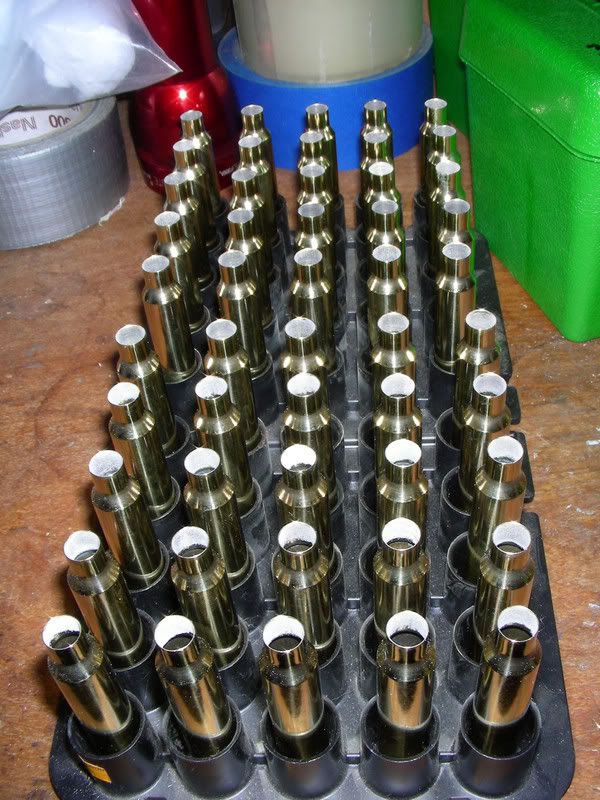 no tumbler running, no fishing out cases, no media in the flash holes or stuck in the case, no dust, no buying media, no buying tumbler polish. Oh hell, I don't have to justify it to you guys! ____________________________________ There are those who would misteach us that to stick in a rut is consistency - and a virtue, and that to climb out of the rut is inconsistency - and a vice. - Mark Twain | Chinese Proverb: When someone shares something of value with you and you benefit from it, you have a moral obligation to share it with others. ___________________________________ | |||
|
| One of Us |
Yeah I had to look all over to find those pics one night and now........ of course right here when I dont need them, but somebody else will. | |||
|
| One of Us |
Woods One of us needs help I think. | |||
|
one of us |
I like Woods' method. I shall have this equipment before long and will start using it. Thanks Woods. Ted Kennedy's car has killed more people than my guns | |||
|
| One of Us |
I've never tumbled brass. I wipe my brass down with a paper towel between case prep and loading primers. Easy enough...never a problem. | |||
|
| One of Us |
They say that you can have brass that is "too clean" meaning a bit of carbon inside the case necks allows some "lube" when seating a bullet, bare brass can affect bullet seating as there is more friction. With untumbled and even somewhat tumbled brass there will be some carbon inside the case neck to allow bullets to seat a bit easier. | |||
|
| One of Us |
CK82 says,
I read somewhere that dirty necks lead to fliers. Any truth to that? I might have read it on this website or some other one. I don't remember... | |||
|
one of us |
I can see where bare brass can affect bullet seating, but keep in mind, there's no lube at all in factory ammo, and there's plenty of it that shoots accurately. I lube all of my inside necks with graphite/alcohol suspension but clean them out first to bare brass. Ted Kennedy's car has killed more people than my guns | |||
|
one of us |
I think there are too many factors that come in to play with respect to fliers. I guess the best shooters to ask would be those who do competition. What do they do for brass prep? If they clean their hulls, then I will keep doing the same. If a benchrest shooter does not worry about it, then perhaps I shouldn't. Ted Kennedy's car has killed more people than my guns | |||
|
One of Us |
IMO the biggest effect on group size that clean or dirty ID of necks has is the effect it has on seating pressure. Variation in seating pressure will cause different OAL's. Mostly not too much but often as much as .005" from one bullet to another. IOW your press has linkages and the whole process has a minute amount of flex from bullet seating stem, shell holders etc. So when you seat a bullet that has a greater seating pressure, that load will have a slightly longer OAL. Don't believe me then next time you are seating bullets and one is a little harder to seat, use a comparator and check it out. Also when you are at the threshold of powder compression and loading a progressively larger powder charge, when you start to compress you will have to thread the seating stem in further to get the same OAL as the uncompressed ones. So if you have a squeeky clean ID then be sure they are all the same, the exact same ID, the exact same amount of burrs or scratches, no diffence in amount of lube left in the neck, same work hardening/annealing etc. etc. etc. Like Doc, I use lube on the inside of the neck (notice the white mica in the pics) or the little can of Imperial Dry Neck Lube 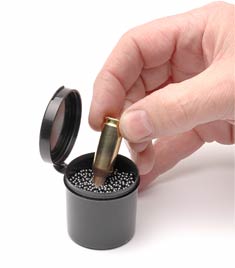 Outside neck turning mandrels and reamers can really tear up the inside of the necks and inside chamfers can leave a minute ledge or burr 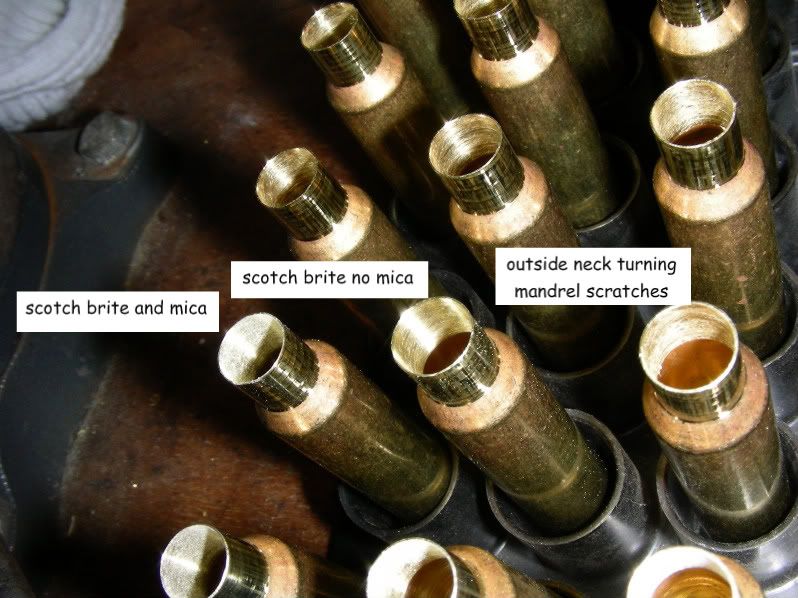 The other factor in seating pressure is absolute control of the ID neck dimension. The Lee Collet neck sizers are the best, the expander ball dies produce close to the exact same ID (but more variation in the finish of the inside of the necks) but the bushing dies produce variations as much as .001" in ID, even after careful outside neck turning. So the question is up about a slight amount of powder residue being better for bullet seating than a completely clean neck without lube, I would have to agree with that. Also a bullet will tend to bond with the neck brass over time so some type of lube or powder residue would help prevent that. JMHO Hey SR, does make the "needing help" worse? ____________________________________ There are those who would misteach us that to stick in a rut is consistency - and a virtue, and that to climb out of the rut is inconsistency - and a vice. - Mark Twain | Chinese Proverb: When someone shares something of value with you and you benefit from it, you have a moral obligation to share it with others. ___________________________________ | |||
|
| One of Us |
| |||
|
| One of Us |
WOW!!! Aim for the exit hole | |||
|
| One of Us |
I too am a non-tumbler. After reading Varmint Al's reloading page I actually took it to an extreme. I never even wiped my cases down after firing. I would just fire them and carfully put them back in the cartridge container. I've been shooting some matches and you have to work the bolt a bit faster. My cases have been hitting the dirt and collecting it. I've run them through my dies if there's no apparent filth. I've got some good dies so the last reloading cycle I simply put them in a gallon bucket with some Tide and mixed them up for a while. It's so dry here they dried overnite while spread out on a towel on the bench. They felt really clean. I've been on the "Chemists.." thread and learned about the vinegar/water/dishwashing solution but not gonna go there. If the vinegar can leach out some copper from the brass if left in too long, it's got to be doing something detrimental. I've never cared how they look, just how they shoot. | |||
|
| One of Us |
I quit tumbling cases years ago. | |||
|
One of Us |
Hey SR, how's this for piling it on? I thought I would see how much detritus is inside the case and see whether it was worth cleaning out. So I took a 22 caliber brush and put a bend in it 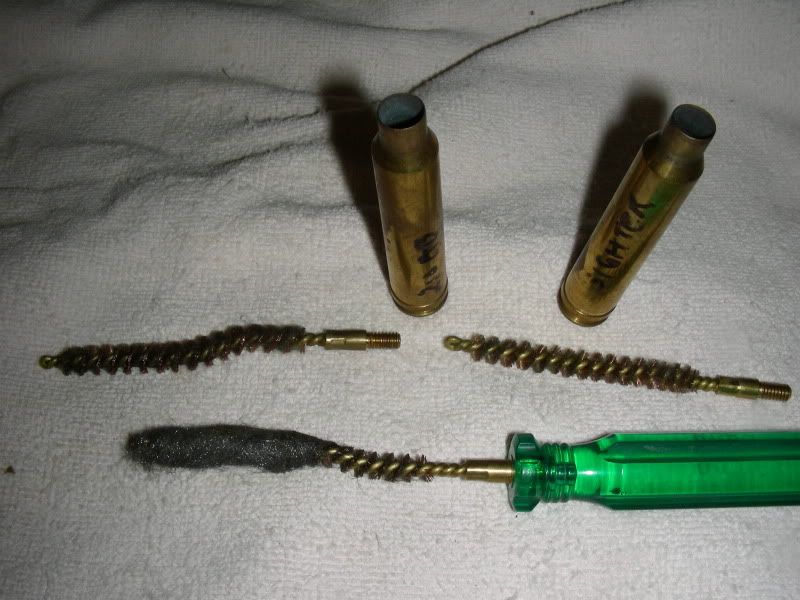 took a multiple fired case and put the brush in and scoured the inside with the steel wool 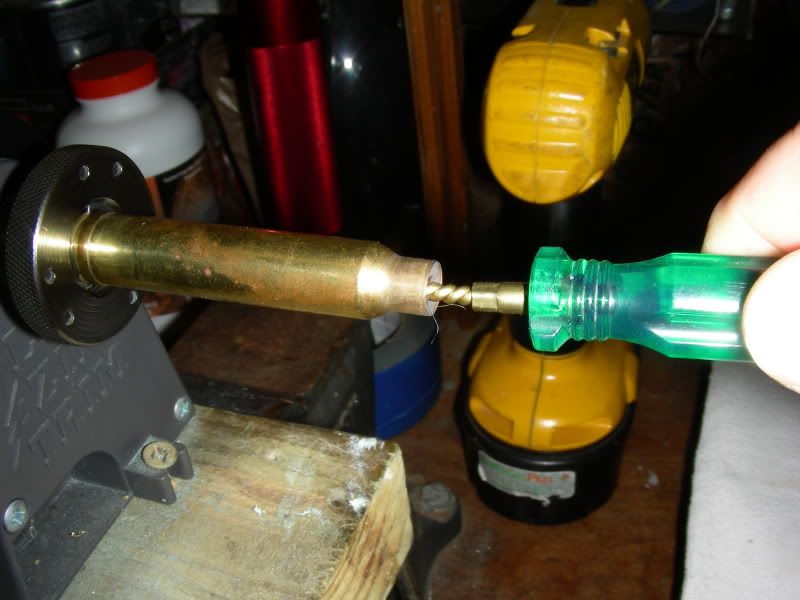 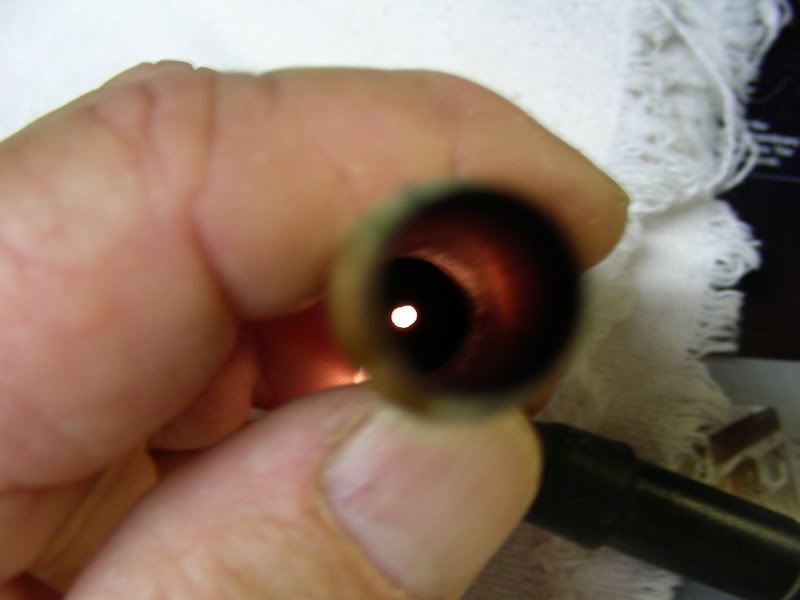 I was amazed at how little powder residue came out. Note the small pile of it just below the brush 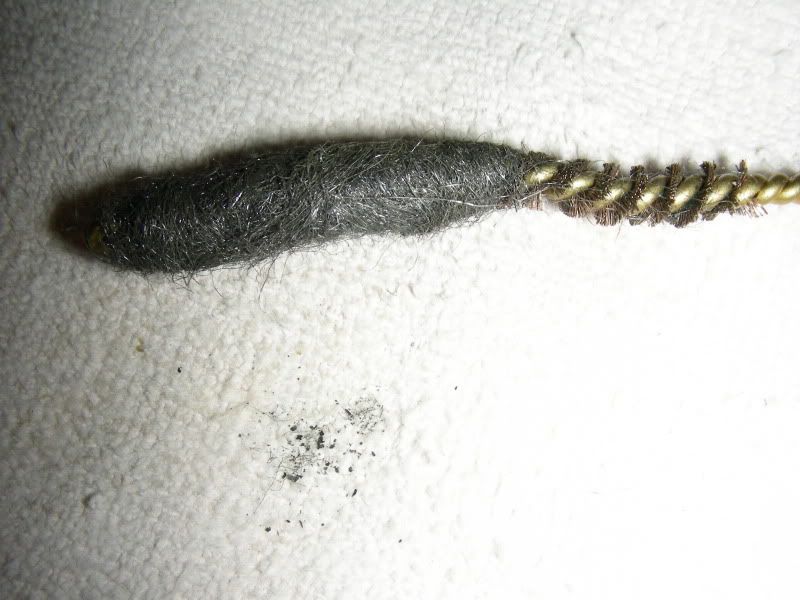 Not worth it but will try it with the next batch of cases I reload and see if it gets any flakes or more residue out. ____________________________________ There are those who would misteach us that to stick in a rut is consistency - and a virtue, and that to climb out of the rut is inconsistency - and a vice. - Mark Twain | Chinese Proverb: When someone shares something of value with you and you benefit from it, you have a moral obligation to share it with others. ___________________________________ | |||
|
| One of Us |
Woods, you've invented a new thingie. Aim for the exit hole | |||
|
| one of us |
I tumble my brass with walnut shells and Brasso I like shiny brass. I don't want to ruin the chamber on any of my rifles or the cylinder on any of my revolvers. Guns cost too much life is too short to have dirty brass. Does it make them shoot any better I doubt it. I don’t like to drive a filthy rusty truck either but it will still get you there. Swede --------------------------------------------------------- NRA Life Member | |||
|
| One of Us |
The crankshaft brush trick is good for decrudding range pick cases that have accumulated sand and dirt after a rain. That does not qualify for OCD since it is accomplishing something meaningful. | |||
|
| One of Us |
Sorry about the delay in answering. Not cleaned, not lubed (except for the graphite inherent in the soot), not polished - for the dirty brass. For the clean brass, just run through a vibratory cleaner with walnut shell (RCBS Formula 1) with their pittle packets of polish. This is my first batch of media, as I only got the machine (Franklin Arsenal vibratory tumbler) last year as a gift. I noticed that the brass seemed to go in and out of the sizing die with more difficulty if it was clean and polished than if it had some soft carbon on it. Lost Sheep | |||
|
| One of Us |
There's another angle on cleaning that hasn't been mentioned yet. Long term brass longevity. I've been reloading for many decades now and when shooting some of my early reloads where the brass wasn't cleaned I have found nearly 100% neck splitting. Even older handloads in new brass and older again WW2 ammunition has not suffered the same fate. I believe that dirty brass has some sort of chemical reaction with firing residue that causes it to become brittle over a very long period of time. So now for ammuniton that I might not use for some years or that I am putting away for the future gets thoroughly cleaned in an U/S machine. I'll get back to you in 20 years to tell you if it helps. | |||
|
| one of us |
| |||
|
| one of us |
Nope! That's season cracking which can happen when loaded ammo is stored over a long period of time. If you'd have annealed the necks before loading that ammo, it most likely would not have happened. You would not expect it with new brass that's never been loaded, but a few years back i loaded up over 500 rounds of .308 Win. in brand new unfired Remington brass. Should have literally lasted forever right, being new an all? Within 6 month necks started to crack andI lost a little over 150 rounds of that ammo. I salvaged the powder and primers, broke down the rest and removed the primers and powder, then annealed the necks. Then, I eloadedall that salvaged brass and still have some holding up just fine after almost ten years of fixing the problem. This was brand new brass with no trnish or dirt, grime or bat poop whatsoever, yet the necks cracked. Getting back to "shiny" brass, I kind of like it. Makes my ammo look like it was professionally done. I may not go that far when doing a load work up and several test series, but once the load has been decided upon, yes, I make that brass very shiny. Doesn't do anything but make it look nice. YMMV. Paul B. | |||
|
| One of Us |
Season cracking or stress corrosion cracking requires brass to become embrittled by chemical attack, usually involving ammonia products. Brass that was improperly annealed in manufacture is more likely to suffer this fate. Annealing the necks again can minimise the risk. The age of the brass (or reloads)is relevant in so far as the chemical reaction can progress further. I agree that my split necks may well have been "season cracking" due to the chemical reaction of firing residue with the brass over decades of storage. That was my suggestion in my post but without using that term. On the other hand even older handloads, using unfired brass from the same batch, did not suffer from split necks. Age alone is clearly not the factor here, the only real difference being new vs fired. Yes, pobably was season cracking but due to firing residue, not just because of the age of the brass. Like I mentioned. I am hoping that proper cleaning of fired brass will prevent this happening. | |||
|
one of us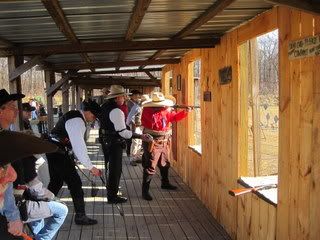 |
My thought exactly! the correct reason to tumble it. | |||
|
| One of Us |
im kinda new to reloading but i dont tumble my cases. i loaded the same case over and over at the range to see how many shots i would get out of a case. every fifth shot i shook it in a milk jug partially full of cleaning solvent. let it dry and i had on average 1.25 inch 3 shot groups with a 500 grain cast lead bullet out of my nef buffalo classic. i got 32 shots out of the casing before it split. if at first you dont succeed. blow it up. | |||
|
| One of Us |
Okay, now, I lied. Dad-in-law's tumbler belongs to me and I tried it. Shiny is good! (I'm so ashamed...) rcamuglia What happened to FD&H (fat dumb and happy)? _______________________ | |||
|
| Powered by Social Strata | Page 1 2 |
| Please Wait. Your request is being processed... |
|
 The Accurate Reloading Forums
The Accurate Reloading Forums  THE ACCURATE RELOADING.COM FORUMS
THE ACCURATE RELOADING.COM FORUMS  Guns, Politics, Gunsmithing & Reloading
Guns, Politics, Gunsmithing & Reloading  Reloading
Reloading  Anybody else shoot "unclean" brass and live to tell about it?
Anybody else shoot "unclean" brass and live to tell about it?

Visit our on-line store for AR Memorabilia

